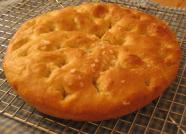| Focaccia al'olio |
 I recently bough Carol Field's The Italian Baker, and have been all excited to try it out, as a book from a new and much recommended author. Then I realised this afternoon, when I was looking through my cookbooks for a bread to have with some soup, that I already owned one of her books, Focaccia. I've never made anything from it, so today I tried the Focaccia al'olio, or focaccia from Genoa, flavoured with olive oil and white wine.
I recently bough Carol Field's The Italian Baker, and have been all excited to try it out, as a book from a new and much recommended author. Then I realised this afternoon, when I was looking through my cookbooks for a bread to have with some soup, that I already owned one of her books, Focaccia. I've never made anything from it, so today I tried the Focaccia al'olio, or focaccia from Genoa, flavoured with olive oil and white wine.
I made a few changes to the recipe, though nothing which should radically affect the taste. I mixed the sponge together at once, rather than letting the yeast start in the water only, since it was easy-start yeast. The original recipe also called for the inside of the oven to be sprayed with water from a spray-bottle several times during the first 10 minutes of cooking; since I can't remember the last time I owned a spray-bottle, I used a pan of water in the bottom of the oven instead. I also didn't have a 10 x 15 inch pan, so I used a 9 inch square pan and an 8 inch diameter cake tin instead.
This dough was far wetter and stickier than most bread doughs I've made before, and I felt very happy to turn the kneading over the KitchenAid. Initially I couldn't believe that the dough was going to spread to fill the two pans after the first rise: it stuck more to my fingers than the pan, and refused to spread more than halfway. I left it alone to relax for about 10 minutes and came back to find that it was now behaving perfectly, and spread happily and without finger-stickage, right to the edges of the pan.
The focaccia turned out to be excellent, worth the slight hassle, with a delicate taste and a very light texture.
Sponge
| 7g active dry yeast |
| 140 g (1 cup) unbleached plain flour |
| 2/3 cup warm water |
Dough
| 1/2 water, room temperature |
| 1/3 cup dry white wine |
| 1/3 cup extra virgin olive oil |
| 2 1/2 cups unbleached plain flour |
| 2 teaspoons sea salt |
Topping
| about 2 tablespoons extra virgin olive oil |
| 1/4 to 1 teaspoon sea salt (Maldon is good) |
To make the sponge, mix together the yeast and the flour in a large mixing bowl, then add the water and beat all together until smooth. Cover tightly, and leave to rise until puffy and bubbling, about 30 minutes.
To make the dough by hand: Add the water, wine and olive oil to the sponge. Whisk in 1 cup of flour and the salt, then beat in the rest of the flour until the dough is very soft and very sticky. Knead on a lightly floured board with 1 or 2 extra tablespoons of flour for 6 to 8 minutes, or until the dough comes together nicely and is silky and shiny. It should remain soft but not wet.
Alternatively, to make the dough in a KitchenAid: Make the sponge in the bowl of the mixer. Attach the paddle and add the water, wine and olive oil to the sponge. Add the flour and salt and mix until the dough comes together while remaining very soft. Change to the dough hook and knead for 3 minutes at medium speed, stopping once or twice to press the dough into a ball to aid in the kneading.
First rise: Place the dough in a lightly oiled container, cover tightly, and let rise until doubled, about 1 hour.
Second rise: The dough should now be soft, full of air bubbles, and stretch easily. Press it into a lightly oiled 10 x 15 inch pan (or two smaller pans). If it won't stretch across the pan, leave it for 10 minutes, then try again once it has relaxed. Dimple the dough with your fingertips, cover with a tea towel, and leave to rise until puffy and doubled, about 45 minutes.
Baking: Preheat the oven to 220 C about 30 minutes before beginning baking. Take the risen dough and dimple it again with your fingertips, then drizzle with olive oil and sprinkle with sea salt. Place the focaccia pan in the oven, and immediately reduce the temperature to 200 C. At the same time, place a pan full of water in the bottom of the oven, to provide light steam. Remove the pan of water after 10 minutes baking. Bake the focaccia for 25 to 30 minutes in total, until it is golden. Immediately remove from the pan and let cool on a rack. If you prefer a slightly crisper base, you can return the focaccia to the oven for another few minutes before cooling, placing the bread directly on the oven rack.
Serves 10.
29 February 2004
| Recipe categories |
| Recent additions |
| Search www.woolfit.com |
| Email me |